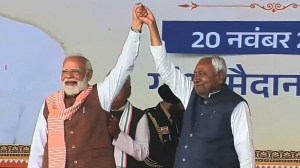Overall expenditure of various grants for development projects has declined to half since 2022-23 in Gujarat: Report
The Gujarat Administrative Reforms Commission, under the chairmanship of the Chief Minister’s Principal Advisor, Hasmukh Adhia, has pointed this out in its fourth report along with nine key recommendations for decentralised planning
 Integrated committee at the taluka level: To replace existing multiple committees at the taluka level for approving development works with a single “Integrated Taluka Planning Committee”.
Integrated committee at the taluka level: To replace existing multiple committees at the taluka level for approving development works with a single “Integrated Taluka Planning Committee”.From 84.75% in 2022-23 to almost 42.4% in 2024-25, the overall expenditure of various grants, majorly for development projects, in Gujarat has declined by half. This has led to a multi-year cycle for fund utilisation and resulted in development works taking longer to complete.
These are among the issues the Gujarat Administrative Reforms Commission (GARC), under the chairmanship of Chief Minister’s Principal Advisor Hasmukh Adhia, has pointed out in its fourth report to CM Bhupendra Patel on Thursday.
The report also comprised nine key recommendations for decentralised planning.
The report stated that stagnant allocation, declining utilisation, accumulation of unspent funds and sectoral imbalance along with lack of interdepartmental coordination, manpower, allocation of work, and budget consideration are systemic challenges that impede Gujarat’s decentralised planning and its effectiveness.
Scheme-wise utilisation of funds for the development projects in three years revealed a more glaring trend. The Discretionary Funds witnessed a decline from 85% in 2022-23 to 48.6% in 2024-25 while MLA fund utilisation dropped from 85% to 28% in the period. Vikassheel Taluka fund utilisation declined from 83.3% to 17% while Incentive Fund utilisation plunged from 89.5% to 47.5%.
The state budget allocation serves as a strategic gap-funding mechanism, with discretionary grants designed to allow flexibility. Key schemes supporting this include Discretionary Grants, the Developmental Taluka Scheme Grant, MLA Local Area Development Scheme Grant, Special Grants for National Festivals, and the Apno Taluko Vibrant Taluko (ATVT) scheme.
GARC, with a mandate to recommend necessary reforms in the administrative framework and governance processes of the state, has submitted three recommendation reports to the state government so far, with a total of 25 recommendations currently at various stages of implementation.
Further, the report highlights the shortage of staff. At present, out of 248 talukas, the total sanctioned strength of Assistant Engineer and Additional Assistant Engineer is 571. Out of this, 435 posts (76%) have been filled and 24% posts are vacant. So, at taluka level, one Assistant Engineer or Additional Assistant Engineer looks after around 54 villages and they monitor around 750 works worth Rs 12 crore every year.
Because of this exorbitant load, monitoring and completion of each work becomes difficult, the report points out.
Highlighting duplication of work where multiple committees operating at the taluka level often select similar works for the same villages, the report said it leads to redundant administrative processes, wasted time and energy, an unbalanced development, manpower shortage, and uneven workload distribution.
The fourth report of GARC presents recommendations that could bring fundamental changes to Gujarat’s planning framework, ensuring direct benefits to citizens. The key recommendations include a seven-to eight-fold increase in the district planning budget over the next five years, transformation of District Planning Boards into District Planning Committees with majority representation of elected representatives, adoption of a fixed planning calendar, creation of integrated committees at the taluka level, and the introduction of Village Development Plans.
The report has put forth several additional recommendations, which include adopting a uniform procedure for project selection across all schemes under the Planning Department (excluding MLA Local Area Development), introducing a technology-driven tracking system, redefining the parameters for identifying developing talukas, and ensuring performance-based accountability.
Key recommendations:
District planning budget to witness 7-8 fold increase in next 5 years: The budget for district planning, which has remained stagnant for years, has now been recommended by the Committee to receive a substantial annual increase of nearly Rs 10,000 crore over the next five years. This enhanced allocation will enable the development of more roads, schools, and healthcare facilities, while also creating greater employment opportunities. Importantly, it will strengthen grassroots governance by ensuring increased participation of local communities in the development process.
From District Planning Board to District Planning Committee: Since 1973, District Planning Boards have existed for planning at the district level. The report recommends that instead of these boards, all district-level planning approvals should now be granted by District Planning Committees, as mandated by the Constitution of India.
Fixed calendar for planning: Introduction of a fixed calendar for planning to streamline processes from project identification under various schemes to administrative approval, tendering, and issuance of work orders. As per this calendar, the planning process for the following year will commence at the village level during June-July of the current year. All administrative procedures will be completed in a manner that ensures actual execution begins from April of the next year.
Integrated committee at the taluka level: To replace existing multiple committees at the taluka level for approving development works with a single “Integrated Taluka Planning Committee”. This unified system will reduce delays, minimise confusion, and enable faster, coordinated decision-making. Ultimately, citizens will directly benefit from the timely implementation of development works.
Village Development Plan: Each village will prepare its own Village Development Plan (VDP), which will then be approved by the Gram Sabha. At the taluka and district levels, the selection of works for approval under development planning will be made strictly on the basis of these Village Development Plans.







